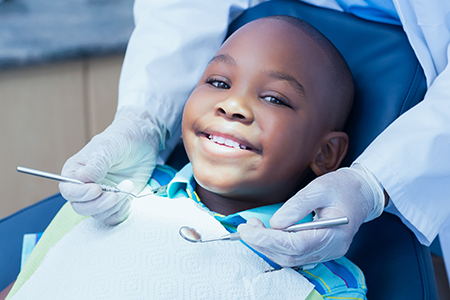New Patients
Existing Patients
New Patients
Existing Patients
New Patients
Existing Patients
New Patients
Existing Patients
New Patients
Existing Patients
New Patients
Existing Patients
New Patients
Existing Patients
New Patients
Existing Patients

At the office of Artistic Family Dental, we focus on nurturing healthy smiles from the very first tooth through adolescence. Pediatric dentistry is more than routine checkups — it’s a partnership between our team and families to build practical habits, prevent problems before they start, and make dental care a positive experience for children.
Our approach combines gentle, evidence-based care with clear guidance for parents. We strive to create visits that reduce anxiety, answer questions, and leave both children and caregivers confident about oral health at every stage of growth.

The best time to influence a lifetime of good oral health is early. By establishing regular dental visits and simple daily habits when teeth first appear, children learn practical routines that reduce decay and support healthy development. These early experiences also shape how kids feel about dental care as they grow.
Our team focuses on gentle instruction and positive reinforcement. During routine visits we evaluate growth, identify early warning signs, and work with parents to tailor home care strategies. Education is always age-appropriate — what a toddler needs to learn is different from what a school-age child requires.
Prevention is about more than brushing and flossing. It includes timely screenings, protective treatments when appropriate, and coaching on nutrition and habits. With consistent attention during childhood, many common problems can be minimized or avoided altogether.
Regular dental checkups are the foundation of pediatric oral care. These visits let our clinicians track tooth eruption, jaw growth, and oral function while catching early signs of cavities or developmental concerns. A proactive surveillance strategy helps reduce the need for more invasive treatment later on.
During an exam we review medical and dental histories, assess the teeth and surrounding tissues, and observe how the bite and jaw are developing. When necessary, we use digital radiographs to get a clearer picture of areas that cannot be seen with the naked eye, such as between teeth or beneath the gums.
Professional cleanings remove plaque and buildup in places that are hard to reach at home and reinforce good oral hygiene techniques. Our team also provides tailored recommendations for home care, fluoride use, and the potential benefits of protective measures such as sealants.

Small, consistent actions at home make a big difference. Parents who model brushing, set a daily routine, and limit sugary snacks help their children adopt habits that protect teeth. Making oral hygiene engaging — with songs, timers, or reward charts — can turn a chore into a healthy ritual.
We emphasize clear, achievable guidance: how to brush and floss by age, when to introduce a smear of fluoride toothpaste, and how to supervise effectively. Nutrition advice is practical, focusing on reducing frequent exposure to sugars and offering tooth-friendly snacks that support growth and oral resilience.
Preventive measures are simple yet powerful. Wearing appropriate mouth protection during sports, considering dental sealants on permanent molars, and following recommended recall intervals are all part of keeping a child’s smile strong through their formative years.
Consistent exams allow us to build a detailed, individualized record of your child’s dental health. Each visit includes a careful clinical review, which helps detect cavities early, monitor jaw and tooth alignment, and identify other issues that can affect oral function or comfort.
Dental X-rays are used selectively to help inform decisions about treatment and growth. Because they provide important information about developing teeth and bone structure, radiographs are taken only when clinically necessary and with modern digital technology to minimize exposure.
After assessment, our team will explain findings in plain language and recommend the next steps — whether that’s preventive care, monitoring, or a treatment plan. Clear explanations help parents and children understand why each recommendation matters.
Tooth decay remains one of the most common childhood health challenges, but it is largely preventable. Decay develops when bacteria, sugars, and time combine to damage enamel. Reducing the frequency of sugary exposures, improving brushing and flossing, and applying protective treatments can interrupt the process.
Early decay can affect eating, speech, and self-confidence, and untreated infections can have broader health impacts. That’s why early identification and minimally invasive interventions are central to our pediatric approach — preserving healthy tooth structure whenever possible.
As part of prevention, we will discuss the targeted use of fluoride and the benefits of sealants for deep grooves on permanent molars. These options are chosen based on your child’s risk profile and evidence-based guidelines.
Begin dental visits early and maintain consistent recall appointments
Encourage daily brushing with a child-sized brush and supervised flossing as teeth touch
Limit sugary drinks and replace frequent snacking with water and tooth-friendly foods
Avoid putting a baby to sleep with bottles containing milk or juice
Model good oral habits so children learn by example
Discuss pacifier use and thumb-sucking with your dentist to plan timely, supportive transitions
Use protective mouthguards for contact sports and active play
Talk to your dental team about fluoride and sealants when your child’s permanent molars erupt

Baby teeth play several essential roles: they help your child eat and speak, support facial development, and hold space for permanent teeth. Caring for these first teeth lays the groundwork for oral health later in life, so establishing a gentle routine early is important.
Parents should begin cleaning a child’s gums and emerging teeth with a soft cloth or infant brush, and transition to a tiny smear of fluoride toothpaste as new teeth come in. Pediatric visits around the time of the first birthday allow us to review feeding practices, growth, and initial oral health care.
Teething can be uncomfortable but is usually managed with simple, safe measures such as chilled teething rings and gentle gum massage. If parents notice unusual swelling, persistent fever, or other concerns, our team is available to evaluate and advise.
Active children sometimes experience dental injuries, from chipped teeth to teeth that become displaced. Knowing how to respond can limit damage: preserve a knocked-out tooth in milk if possible, rinse and reinsert if appropriate, and seek prompt dental attention. Quick action often improves outcomes.
Other common urgent issues include toothaches, infections, and soft-tissue cuts. Our practice is prepared to assess pain, diagnose the cause, and recommend timely, compassionate care that prioritizes comfort and long-term oral health.
When a child’s medical condition, anxiety, or age makes routine care difficult, we discuss suitable behavior-management strategies. Our goal is to deliver effective care while minimizing stress for both child and caregiver.
As children mature, monitoring jaw growth and tooth alignment becomes increasingly important. Early screening lets us identify habits or developmental patterns that might benefit from early referral or intervention. In many cases, timely guidance can simplify future orthodontic treatment.
Good nutrition supports healthy teeth and tissues. Limiting sticky sweets and frequent sugary beverages reduces decay risk, while balanced meals rich in calcium and vitamins support tooth and bone development. Practical family choices make a meaningful difference in oral health outcomes.
For children who play sports, properly fitted mouthguards are a simple, effective way to protect teeth and reduce the risk of dental injuries. We can advise on the best protective gear based on your child’s activities and needs.
Dentists watch how teeth and jaws develop across childhood to spot potential alignment concerns early. If an issue is suspected, we’ll outline options — from observation and habit counseling to timely orthodontic referral — to support the healthiest outcome for your child’s smile.
Early intervention can sometimes prevent more complex problems later, so open communication between parents, general dentists, and orthodontic specialists helps ensure coordinated care when needed.
We tailor recommendations to each child’s development and keep families informed about milestones and options so they can make confident decisions.
Healthy eating habits and mindful snacking are central to preventing decay. We encourage choices that limit prolonged exposure to sugars and promote foods that contribute to strong teeth and gums. Simple swaps and consistent routines have long-term benefits.
Habits like prolonged bottle use, frequent juice consumption, or lingering pacifier use can influence dental health and growth; we provide supportive strategies to address these behaviors at the right time.
Additionally, protective treatments such as sealants for newly erupted molars and topical fluoride where appropriate are evidence-based tools we use to lower a child’s risk of cavities.
In summary, pediatric dentistry is about prevention, early detection, and partnering with families to support children’s health at every stage. If you’d like to learn more about how our team helps children build confident, healthy smiles, please contact us for additional information.

A pedodontist is a dentist who has received advanced specialty training in meeting the dental needs of children from infancy to adolescence. Pedodontists, also referred to as "pediatric dentists," study child psychology, behavior management, caring for children with special needs, methods of handling oral/facial trauma, and various techniques for providing anesthesia and sedation. Pedodontists also understand the complexities of facial growth and development and have the clinical skills required to meet the dental needs of all children at every stage of development. Most of all, pedodontists are passionate about what they do and enjoy working with children. They strive to make every dental experience a positive one as they help children establish a strong foundation for good oral health.
Even before your child is born, their first set of teeth is already forming. In fact, by one year of age, some of your baby's front teeth will have already come into place. While the arrival of your baby's first teeth is only one of many developmental milestones, it represents an excellent time to begin a program of oral care. According to recommendations from the American Dental Association, babies should see the dentist around the time of their first birthdays.
Your baby's first teeth typically begin to appear in the 6 to 12-month range. While this is an extraordinary milestone, you need to be aware that your baby may find the experience a little bit uncomfortable. Teething can make babies feel irritable. They may be fussy, have trouble sleeping, not want to eat, and drool quite a bit.
Although you are powerless to speed up the process of teething, there are a few things that you can do to soothe your baby as the new teeth are erupting into place. Common approaches to helping your baby feel more comfortable while getting new teeth, include teething rings or a cold spoon or moist gauze rubbed over their gums.
Even for these few new teeth, it's absolutely essential to establish an effective regimen of oral care. For information on when your baby's first set of teeth will erupt into place, consult this timeline from the American Dental Association: Eruption Charts
Some children persist in sucking their thumbs or fingers beyond their preschool years. For these children, the activity continues to be a source of comfort, relaxation, and security. It may even help them fall asleep at night. However, it's essential to be aware that in the long-term, a finger sucking habit is not healthy.
If your child's thumb or finger sucking habit is still present when the permanent teeth begin to come in, your child is at a higher risk of developing a bad bite. By the age of five or six years, you need to constructively and gently help your child stop the habit.
It's also a good idea to have a comprehensive evaluation at this time. Your pedodontist can assess if there are any habit related alterations to the alignment of your child's teeth or jaws, or if it is affecting their speech or swallowing patterns. They can also discuss habit control strategies with you, as well as follow your child's bite and facial development as they grow. If interceptive appliances or corrective orthodontic care are recommended, the timetable and best options in care will be explained in complete detail.
The American Academy of Pediatric Dentistry and most pediatric dental experts recommend a first visit by the time a child's first tooth appears or by their first birthday. Early visits allow clinicians to check eruption patterns, evaluate oral tissues, and review feeding and hygiene practices before problems develop. These appointments also give parents practical guidance and set the stage for comfortable, routine care.
At the office of Artistic Family Dental we encourage early exams because they help establish positive habits and create a baseline record for each child. Early familiarity with the dental setting reduces anxiety and makes future preventive care more effective. Parents who start care early often find that small issues are easier to manage than later complications.
A typical pediatric dental exam includes a review of medical and dental history, a gentle clinical assessment of the teeth and gums, and observation of how the bite and jaw are developing. The clinician will check for signs of decay, evaluate eruption sequence, and assess soft tissues for any concerns that might affect oral function. Exams are age-appropriate and delivered in a way that keeps children comfortable and informed.
When clinically indicated, digital radiographs may be taken to view areas that are not visible during the clinical exam, such as between teeth or beneath the gumline, using technology that minimizes exposure. Professional cleanings remove plaque and reinforce home care techniques, while the team will discuss preventive options like fluoride and sealants based on each child’s risk. After the visit, the dentist explains findings and provides clear recommendations for follow-up or home care.
Pediatric dental teams use proven behavior-management techniques to reduce anxiety and build trust, including the tell-show-do approach, positive reinforcement, distraction, and age-appropriate explanations. These strategies help children understand what to expect and participate cooperatively, which improves the quality of care and their long-term attitude toward dentistry. The environment, staff demeanor, and consistent routines all contribute to calmer visits.
For children with significant anxiety, strong gag reflexes, or medical needs that make treatment difficult, the practice discusses additional options such as nitrous oxide administered by trained providers to help manage discomfort and fear. Any adjunctive measures are selected carefully, explained in plain language to parents, and used only when they enhance safety and the child’s ability to tolerate necessary care. The emphasis is always on minimizing stress while delivering effective treatment.
Preventing tooth decay starts with consistent daily habits: brushing twice a day with an age-appropriate toothbrush and a smear or pea-sized amount of fluoride toothpaste as recommended, supervising flossing once teeth touch, and avoiding prolonged exposure to sugary drinks. Limiting frequent snacking on sugary or sticky foods and offering water between meals reduces the time teeth are exposed to damaging acids. Modeling good oral hygiene and establishing routines are powerful tools for long-term prevention.
In addition to home care, routine dental visits allow the team to apply evidence-based preventive treatments when appropriate, such as topical fluoride and sealants on newly erupted permanent molars. The dental team also provides tailored nutrition guidance to reduce decay risk while supporting growth and overall health. Combining consistent home habits with professional preventive care greatly lowers the likelihood of cavities and more invasive treatment later on.
Exposure is kept as low as reasonably achievable by using digital sensors, protective shielding, and evidence-based protocols. The dental team will explain the reason for any recommended images and how they inform diagnosis and treatment planning. Parents always have the opportunity to ask questions and receive clear guidance about the benefits and safety measures in place.
Baby teeth play critical roles in a child’s oral and overall development: they enable proper chewing and nutrition, support clear speech development, guide the eruption and spacing of permanent teeth, and contribute to normal facial growth. Losing baby teeth prematurely because of decay or infection can lead to misalignment, speech difficulties, and problems with chewing. Protecting primary teeth preserves function and helps ensure smoother transitions to the permanent dentition.
Treating decay in baby teeth is often focused on preserving tooth structure and preventing infection, which supports comfort, nutrition, and confidence in the child. The dental team prioritizes minimally invasive approaches when possible and discusses monitoring strategies when immediate treatment isn’t necessary. Keeping baby teeth healthy reduces the risk of complications that can affect future oral health.
In many urgent situations, quick and appropriate action improves outcomes. For a knocked-out permanent tooth, if the child is old enough and the tooth is whole, try to reinsert it gently and seek immediate care or store the tooth in milk while you travel to the dental office; for primary (baby) teeth, do not attempt reimplantation and consult the dentist promptly. For severe pain, swelling, or signs of infection, contact your dental provider right away so the cause can be diagnosed and treated to prevent complications.
Other common emergencies include chipped teeth, soft-tissue cuts, and objects lodged between teeth; rinsing with clean water, controlling bleeding with gentle pressure, and saving any tooth fragments can be helpful prior to evaluation. The dental team will assess the injury, recommend the appropriate urgent or follow-up care, and discuss pain control and infection prevention. Prompt attention preserves oral health and reduces the chance of more extensive treatment later.
Orthodontic screening is often recommended by around age 7, when the dentist can evaluate the relationship between the jaws, the pattern of eruption, and early signs of crowding or bite problems. Early screening does not always lead to immediate treatment, but it allows the dental team to identify developmental issues that may benefit from monitoring or early intervention. Detecting concerns early can simplify or shorten later orthodontic care in some cases.
If the dentist observes habits such as prolonged thumb-sucking, significant asymmetry, or crossbites, they may recommend habit counseling, growth guidance, or a referral to an orthodontic specialist for further assessment. Coordination between the general dentist and orthodontist ensures that any intervention is timed appropriately for the child’s growth. Families receive clear explanations of options so they can make informed decisions about timing and goals.
Dental sealants are thin protective coatings applied to the chewing surfaces of newly erupted permanent molars to fill deep grooves and prevent food and bacteria from becoming trapped. Sealants are quick to place, painless, and effective at reducing decay risk on vulnerable surfaces. Topical fluoride strengthens enamel and helps resist acid attack, and it is applied in-office in concentrations appropriate for a child’s age and risk profile.
Decisions about sealants and fluoride are personalized based on the child’s dental history, cavity risk, and developmental stage. The dental team will explain the expected benefits, the application process, and any necessary follow-up so parents understand how these preventive tools fit into a broader care plan. When combined with good home habits and regular checkups, sealants and fluoride are powerful defenses against cavities.
Begin by cleaning an infant’s gums with a soft cloth after feedings and transition to an infant toothbrush as teeth emerge, using a smear of fluoride toothpaste until age 3 and a pea-sized amount thereafter unless otherwise advised. Brush twice daily, supervise young children until they can reliably spit, and begin flossing when adjacent teeth touch. Limiting nighttime bottles with milk or juice and offering water between meals helps reduce decay risk.
For teething discomfort, safe measures such as chilled teething rings and gentle gum massage are typically effective, and parents should contact the dental team if they notice persistent fever or unusual swelling. Discuss pacifier or thumb-sucking habits with your dentist so you can plan supportive, timely transitions when needed. The practice at Artistic Family Dental can provide personalized home-care guidance and answer questions about developmental milestones and preventive strategies.

Ready to schedule your next appointment or learn more about our services?
Our friendly team is here to make it easy. Whether you’d like to call, email, or use our convenient online form, we’ll help you find the right time and answer any questions you have. Don’t wait to take the next step toward a healthier, more confident smile—contact Artistic Family Dental today and experience the difference genuine, personalized care can make.